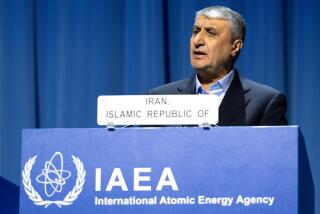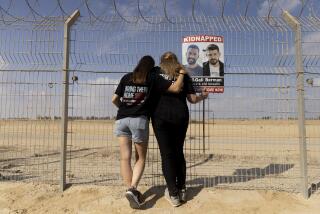How Iran killed its future
- Share via
Imagine where the U.S. economy would be today if John Jacob Astor, Cornelius Vanderbilt, Andrew Carnegie or any of the magnates who helped turn America into an industrialized society had been gunned down by a revolutionary firing squad. In 1979, that is what happened in Iran to my grandfather, Habib Elghanian, Iran’s most prominent Jewish industrialist and philanthropist. My grandfather’s execution was not only a personal loss but a turning point for Iran.
His execution and the subsequent fleeing of businessmen from Iran contributed to derailing the country’s chances of building a modern, diversified, export-based economy, and foreshadowed Iran’s neglect of its most valuable resource: its people. Since the revolution in 1979, a new generation of Iranians has been left to foot the hefty losses caused by the Islamic Republic’s hostility to independent businessmen, its fixation on oil, uranium and nuclear power and its cantankerous rhetoric against Israel.
In the months after Ayatollah Ruhollah Khomeini’s return to Iran on Feb. 1, 1979, about 200 former high-ranking members of the shah’s security forces, military and government were killed, many charged with “association with the shah’s regime.” That May, my grandfather was the first businessman to be executed. During a show trial that lasted no longer than 20 minutes, he was falsely charged with being a “Zionist spy” and a “corrupter on Earth.” Newspaper stories and editorials around the world, including in the Los Angeles Times, carried the news of the execution of “Iran’s plastics king.”
My grandfather’s crime, according to the prosecutor, was making financial contributions to Israel and meeting with Israeli politicians when they came to Iran or when he traveled to Israel — as was customary for leaders of the Jewish diaspora. He was the leader of Iran’s 80,000 to 100,000 Jews in the 1960s and 1970s when Iran and Israel enjoyed peaceful, if not always cordial, relations under the shah. Not mentioned was how hard he had worked to form partnerships with Muslim and Armenian businessmen, how he had rehabilitated hospitals — including one in which injured revolutionaries were treated — and had funded charities to help poor schoolchildren and the elderly.
It didn’t matter that even as members of the elite were fleeing the country with their money, my grandfather had returned to Iran from a brief visit to the U.S. and Israel in November 1978. “I have done nothing wrong; I’m going home,” he said. The prosecutor instead focused on his contributions to Israel and concluded that made him “a friend of God’s foes and a foe of God’s friends.”
My grandfather grew up poor. He began working in an uncle’s hotel at 15, went on to become a merchant in a bazaar and later, along with his brothers, spent decades building factories, creating thousands of jobs, producing modestly priced goods for a growing middle class and laying the foundations for an Iranian export industry.
For 30 years, the family played a pioneering role in Iran’s modernization and industrialization, building the first high-rise and shopping arcades in Iran. An aluminum factory manufactured household goods including refrigerators, and a plastics factory mass-produced simple consumer products never before made in Iran.
In the early 1970s, my grandfather and other industrialists who belonged to the Iranian Chamber of Commerce were invited to China to lay the groundwork for trade between the two nations. China became Iran’s biggest trade partner, but an average 80% of what Iran exports to China is oil, not manufactured goods. Today, it is the “Made in China” label that has become ubiquitous globally. When I think of how Iran’s economy was more modern than China’s and India’s before the Iranian revolution, it saddens and frustrates me that Iranian oil has helped fuel both those nations’ prosperity while Iran’s modernization came to a halt. Even worse is seeing how it is the U.S.-born children of Indian and Chinese immigrants who are now starting their own companies in their families’ former homelands.
If Iran after the 1979 revolution had nurtured, rather than ended, entrepreneurs’ visions for the country, wouldn’t businessmen such as YouTube Chief Executive Salar Kamangar, Expedia President Dara Khosrowshahi, MGA Entertainment Chief Executive Isaac Larian and EBay founder Pierre Omidyar have helped transform Iran into a 21st century economic powerhouse? The first three were born in Iran; Omidyar’s father is Iranian.
Whether Iran’s nuclear program is to build a bomb, create nuclear energy or extend its influence in the Middle East, the country has sabotaged its own interests by focusing heavily on that sector and leaving little opportunity for economic diversification. A new generation of Iranians, eager for opportunities to create and mold its future, clamors for political, civil and economic liberties. More than 20% of Iranians younger than 24 are unemployed. Without prospects for new private sector jobs, innovations that attract investments and open new trade opportunities, the educated youth leave, if they can afford it.
It was puzzling in March to hear Iran’s leaders suggest that the nation “lift our domestic production” to stave off inflation and unemployment and strengthen the economy. That very principle — favoring products made in Iran by Iranians — was what my grandfather and other Iranian industrialists had long championed.
If their efforts had not been quashed, the headlines about Tehran might have been about Iran’s latest crop of titans building a modern, prosperous and stable economy, serving as an example for the rest of the region. Instead, they will continue to be about the tribulations of a nation investing its energy in the wrong resources.
Shahrzad Elghanayan, a news photo editor, is working on a book about her grandfather.
More to Read
A cure for the common opinion
Get thought-provoking perspectives with our weekly newsletter.
You may occasionally receive promotional content from the Los Angeles Times.










